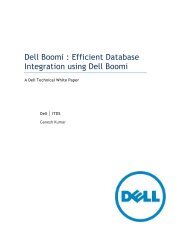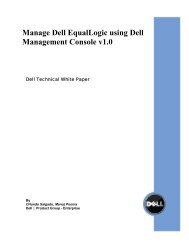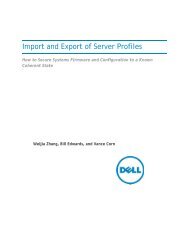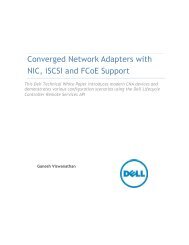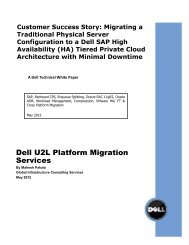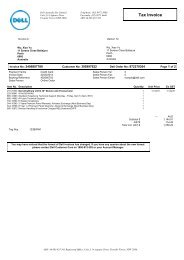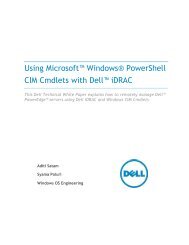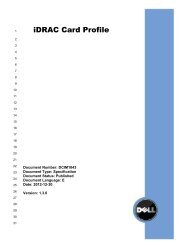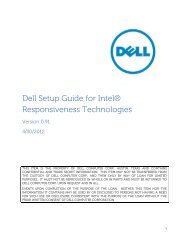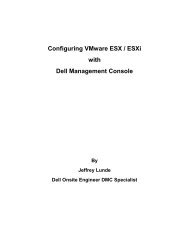BIOS Performance and Power Tuning Guidelines ... - Dell Community
BIOS Performance and Power Tuning Guidelines ... - Dell Community
BIOS Performance and Power Tuning Guidelines ... - Dell Community
You also want an ePaper? Increase the reach of your titles
YUMPU automatically turns print PDFs into web optimized ePapers that Google loves.
Normalized <strong>Performance</strong><br />
<strong>BIOS</strong> <strong>Performance</strong> <strong>and</strong> <strong>Power</strong> <strong>Tuning</strong> <strong>Guidelines</strong> for <strong>Dell</strong> <strong>Power</strong>Edge 12th Generation Servers<br />
Figure 6 illustrates that local <strong>and</strong> remote latency are generally not affected significantly by changing<br />
the available Memory Operating Modes. For measures of memory latency (measured in nanoseconds),<br />
lower measurements are better. However, under the loaded latency test, we see that Advanced ECC,<br />
Mirror Mode, <strong>and</strong> Advanced ECC with Sparing all encounter considerably higher latencies than the<br />
other modes. For Advanced ECC mode, the latencies are approximately 225% that of Optimizer mode,<br />
suggesting that there is a reduction in memory b<strong>and</strong>width that is increasing queuing times <strong>and</strong> driving<br />
the loaded latency measurement upwards. Similarly, Advanced ECC with Sparing encounters a<br />
reduction in loaded latency of approximately the same magnitude. The Memory Mirror mode<br />
encounters loaded latencies approximately 40% higher than Optimizer mode.<br />
Figure 6.<br />
Comparison of memory mode effects<br />
Memory Mode Effects on Latency Characteristics<br />
2.50<br />
2.00<br />
2.25<br />
2.24<br />
1.50<br />
Local Latency<br />
1.00<br />
1.00<br />
1.00<br />
1.00<br />
1.00<br />
1.00<br />
1.03<br />
1.00<br />
1.40<br />
0.99<br />
1.00<br />
1.00<br />
1.00<br />
1.01<br />
Remote Latency<br />
Loaded Latency<br />
0.50<br />
0.00<br />
Optimizer Advanced ECC Mirror Sparing Advanced ECC<br />
Sparing<br />
Memory Mode<br />
<strong>Performance</strong> impacts of Advanced ECC <strong>and</strong> Optimizer Mode<br />
Because Optimizer <strong>and</strong> Advanced ECC Modes are the two most common Memory Operating Modes<br />
for customers, these two selections are compared against one another for additional performance<br />
detail. Examining Figure 7, we can see that the memory b<strong>and</strong>width measured in Advanced ECC mode<br />
is only 55% of that for Optimizer mode. This decline in memory b<strong>and</strong>width translates into other server<br />
workload impacts as well. Additionally, we can see that SPEC_int_rate_base2006 with Advanced ECC<br />
mode achieving only 87% of the performance seen with Optimizer mode. For the more memory<br />
b<strong>and</strong>width-sensitive SPECfp_rate_base2006 benchmark, we see Advanced ECC achieving only 71% of<br />
the performance seen with Optimizer mode. With the Java-based SPECjbb2005 benchmark, the<br />
impacts are considerably less pronounced. For SPECjbb2005, Advanced ECC mode achieves a full 97%<br />
of the performance of Optimizer mode.<br />
13




